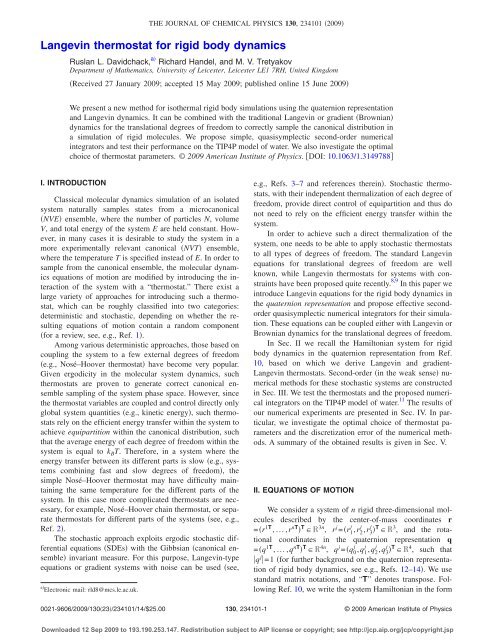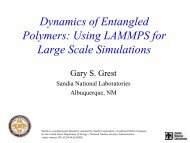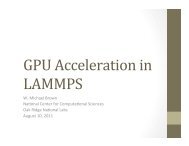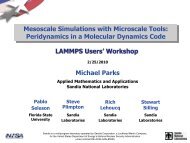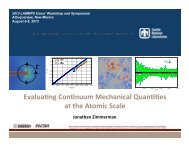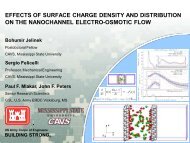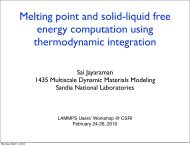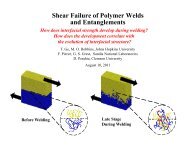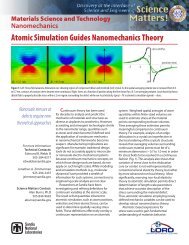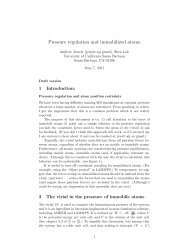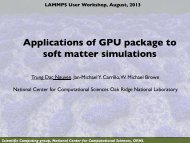Langevin thermostat for rigid body dynamics - Lammps
Langevin thermostat for rigid body dynamics - Lammps
Langevin thermostat for rigid body dynamics - Lammps
You also want an ePaper? Increase the reach of your titles
YUMPU automatically turns print PDFs into web optimized ePapers that Google loves.
THE JOURNAL OF CHEMICAL PHYSICS 130, 234101 2009<br />
<strong>Langevin</strong> <strong>thermostat</strong> <strong>for</strong> <strong>rigid</strong> <strong>body</strong> <strong>dynamics</strong><br />
Ruslan L. Davidchack, a Richard Handel, and M. V. Tretyakov<br />
Department of Mathematics, University of Leicester, Leicester LE1 7RH, United Kingdom<br />
Received 27 January 2009; accepted 15 May 2009; published online 15 June 2009<br />
We present a new method <strong>for</strong> isothermal <strong>rigid</strong> <strong>body</strong> simulations using the quaternion representation<br />
and <strong>Langevin</strong> <strong>dynamics</strong>. It can be combined with the traditional <strong>Langevin</strong> or gradient Brownian<br />
<strong>dynamics</strong> <strong>for</strong> the translational degrees of freedom to correctly sample the canonical distribution in<br />
a simulation of <strong>rigid</strong> molecules. We propose simple, quasisymplectic second-order numerical<br />
integrators and test their per<strong>for</strong>mance on the TIP4P model of water. We also investigate the optimal<br />
choice of <strong>thermostat</strong> parameters. © 2009 American Institute of Physics. DOI: 10.1063/1.3149788<br />
I. INTRODUCTION<br />
Classical molecular <strong>dynamics</strong> simulation of an isolated<br />
system naturally samples states from a microcanonical<br />
NVE ensemble, where the number of particles N, volume<br />
V, and total energy of the system E are held constant. However,<br />
in many cases it is desirable to study the system in a<br />
more experimentally relevant canonical NVT ensemble,<br />
where the temperature T is specified instead of E. In order to<br />
sample from the canonical ensemble, the molecular <strong>dynamics</strong><br />
equations of motion are modified by introducing the interaction<br />
of the system with a “<strong>thermostat</strong>.” There exist a<br />
large variety of approaches <strong>for</strong> introducing such a <strong>thermostat</strong>,<br />
which can be roughly classified into two categories:<br />
deterministic and stochastic, depending on whether the resulting<br />
equations of motion contain a random component<br />
<strong>for</strong> a review, see, e.g., Ref. 1.<br />
Among various deterministic approaches, those based on<br />
coupling the system to a few external degrees of freedom<br />
e.g., Nosé–Hoover <strong>thermostat</strong> have become very popular.<br />
Given ergodicity in the molecular system <strong>dynamics</strong>, such<br />
<strong>thermostat</strong>s are proven to generate correct canonical ensemble<br />
sampling of the system phase space. However, since<br />
the <strong>thermostat</strong> variables are coupled and control directly only<br />
global system quantities e.g., kinetic energy, such <strong>thermostat</strong>s<br />
rely on the efficient energy transfer within the system to<br />
achieve equipartition within the canonical distribution, such<br />
that the average energy of each degree of freedom within the<br />
system is equal to k B T. There<strong>for</strong>e, in a system where the<br />
energy transfer between its different parts is slow e.g., systems<br />
combining fast and slow degrees of freedom, the<br />
simple Nosé–Hoover <strong>thermostat</strong> may have difficulty maintaining<br />
the same temperature <strong>for</strong> the different parts of the<br />
system. In this case more complicated <strong>thermostat</strong>s are necessary,<br />
<strong>for</strong> example, Nosé–Hoover chain <strong>thermostat</strong>, or separate<br />
<strong>thermostat</strong>s <strong>for</strong> different parts of the systems see, e.g.,<br />
Ref. 2.<br />
The stochastic approach exploits ergodic stochastic differential<br />
equations SDEs with the Gibbsian canonical ensemble<br />
invariant measure. For this purpose, <strong>Langevin</strong>-type<br />
equations or gradient systems with noise can be used see,<br />
a Electronic mail: rld8@mcs.le.ac.uk.<br />
e.g., Refs. 3–7 and references therein. Stochastic <strong>thermostat</strong>s,<br />
with their independent thermalization of each degree of<br />
freedom, provide direct control of equipartition and thus do<br />
not need to rely on the efficient energy transfer within the<br />
system.<br />
In order to achieve such a direct thermalization of the<br />
system, one needs to be able to apply stochastic <strong>thermostat</strong>s<br />
to all types of degrees of freedom. The standard <strong>Langevin</strong><br />
equations <strong>for</strong> translational degrees of freedom are well<br />
known, while <strong>Langevin</strong> <strong>thermostat</strong>s <strong>for</strong> systems with constraints<br />
have been proposed quite recently. 8,9 In this paper we<br />
introduce <strong>Langevin</strong> equations <strong>for</strong> the <strong>rigid</strong> <strong>body</strong> <strong>dynamics</strong> in<br />
the quaternion representation and propose effective secondorder<br />
quasisymplectic numerical integrators <strong>for</strong> their simulation.<br />
These equations can be coupled either with <strong>Langevin</strong> or<br />
Brownian <strong>dynamics</strong> <strong>for</strong> the translational degrees of freedom.<br />
In Sec. II we recall the Hamiltonian system <strong>for</strong> <strong>rigid</strong><br />
<strong>body</strong> <strong>dynamics</strong> in the quaternion representation from Ref.<br />
10, based on which we derive <strong>Langevin</strong> and gradient-<br />
<strong>Langevin</strong> <strong>thermostat</strong>s. Second-order in the weak sense numerical<br />
methods <strong>for</strong> these stochastic systems are constructed<br />
in Sec. III. We test the <strong>thermostat</strong>s and the proposed numerical<br />
integrators on the TIP4P model of water. 11 The results of<br />
our numerical experiments are presented in Sec. IV. In particular,<br />
we investigate the optimal choice of <strong>thermostat</strong> parameters<br />
and the discretization error of the numerical methods.<br />
A summary of the obtained results is given in Sec. V.<br />
II. EQUATIONS OF MOTION<br />
We consider a system of n <strong>rigid</strong> three-dimensional molecules<br />
described by the center-of-mass coordinates r<br />
=r 1T ,...,r nT T R 3n , r j =r 1 j ,r 2 j ,r 3 j T R 3 , and the rotational<br />
coordinates in the quaternion representation q<br />
=q 1T ,...,q nT T R 4n , q j =q 0 j ,q 1 j ,q 2 j ,q 3 j T R 4 , such that<br />
q j =1 <strong>for</strong> further background on the quaternion representation<br />
of <strong>rigid</strong> <strong>body</strong> <strong>dynamics</strong>, see e.g., Refs. 12–14. We use<br />
standard matrix notations, and “T” denotes transpose. Following<br />
Ref. 10, we write the system Hamiltonian in the <strong>for</strong>m<br />
0021-9606/2009/13023/234101/14/$25.00<br />
130, 234101-1<br />
© 2009 American Institute of Physics<br />
Downloaded 12 Sep 2009 to 193.190.253.147. Redistribution subject to AIP license or copyright; see http://jcp.aip.org/jcp/copyright.jsp
234101-2 Davidchack, Handel, and Tretyakov J. Chem. Phys. 130, 234101 2009<br />
Hr,p,q, = pT p<br />
2m + <br />
n<br />
<br />
l=1<br />
j=1<br />
3<br />
V l q j , j + Ur,q,<br />
where p=p 1T ,...,p nT T R 3n , p j =p j 1 , p j 2 , p j 3 T R 3 , are the<br />
center-of-mass momenta conjugate to r, = 1T ,..., nT T<br />
R 4n , j = j 0 , j 1 , j 2 , j 3 T R 4 , are the angular momenta<br />
conjugate to q, and Ur,q is the potential interaction energy.<br />
The second term represents the rotational kinetic energy<br />
of the system with<br />
V l q, = 1 T S l q 2 , q, R 4 , l = 1,2,3, 2<br />
8I l<br />
where the three constant four-by-four matrices S l are such<br />
that<br />
S 1 q = − q 1 ,q 0 ,q 3 ,− q 2 T , S 2 q = − q 2 ,− q 3 ,q 0 ,q 1 T ,<br />
S 3 q = − q 3 ,q 2 ,− q 1 ,q 0 T ,<br />
and I l are the principal moments of inertia of the <strong>rigid</strong> molecule.<br />
The Hamilton equations of motion are<br />
dr<br />
dt = p m ,<br />
3<br />
dp<br />
dt =− rUr,q,<br />
dq j<br />
dt = jV l q j , j ,<br />
l=1<br />
d j<br />
dt<br />
3<br />
=− q jV l q j , j − q jUr,q,<br />
l=1<br />
j =1, ...,n.<br />
It is easy to check that if the initial conditions are chosen<br />
such that q j 0=1, then the corresponding Hamilton equations<br />
of motion ensure that<br />
q j t =1, j =1, ...,n <strong>for</strong> all t 0. 4<br />
In the rest of this section we derive stochastic <strong>thermostat</strong>s<br />
<strong>for</strong> this molecular system, which preserve Eq. 4. They<br />
take the <strong>for</strong>m of ergodic SDEs with the Gibbsian canonical<br />
ensemble invariant measure possessing the density<br />
r,p,q, exp− Hr,p,q,,<br />
where =1/k B T0 is an inverse temperature.<br />
A. <strong>Langevin</strong>-type equations<br />
Consider the <strong>Langevin</strong>-type equations in the <strong>for</strong>m of<br />
Ito, 15<br />
dR j = Pj<br />
m dt, Rj 0 = r j ,<br />
dP j =− r jUR,Qdt − gP j ,R j dt<br />
1<br />
3<br />
5<br />
+ bR j dw j t, P j 0 = p j , 6<br />
3<br />
dQ j = jV l Q j , j dt, Q j 0 = q j , q j =1,<br />
l=1<br />
3<br />
d j =− q jV l Q j , j dt − q jUR,Qdt<br />
l=1<br />
− GQ j , j dt + BQ j , j dW j t, j 0 = j ,<br />
j =1, ...,n,<br />
where 0 and 0 with 0 are the friction coefficients<br />
<strong>for</strong> the translational and rotational motions, respectively,<br />
measured in units of inverse time, which control the<br />
strength of coupling of the system to the “heat bath;” g is a<br />
three-dimensional appropriately normalized vector; G is a<br />
four-dimensional vector, which provides a balance in coupling<br />
various rotational degrees of freedom with the heat<br />
bath; b and B are three-by-three and four-by-four matrices,<br />
respectively; and w T ,W T T =w 1T ,...,w nT ,W 1T ,...,W nT T<br />
is a 3n+4n-dimensional standard Wiener process with w j<br />
=w 1 j ,w 2 j ,w 3 j T and W j =W 0 j ,W 1 j ,W 2 j ,W 3 j T .<br />
For simplicity, we assumed here that g, G, b, and B are<br />
the same <strong>for</strong> all n molecules, although one could choose<br />
them depending on the molecule number j. The latter can be<br />
especially useful <strong>for</strong> systems consisting of significantly different<br />
types of molecules. It is also natural to require that<br />
each degree of freedom is thermalized by its own independent<br />
noise, and in what follows we assume that the matrices<br />
b and B are diagonal. Further, we suppose that the coefficients<br />
of system 6-7 are sufficiently smooth functions and<br />
the process Xt=R T t,P T t,Q T t, T t T is ergodic, i.e.,<br />
there exists a unique invariant measure of X and independently<br />
of xR 14n there exists the limit<br />
lim EXt;x = xdx ª erg<br />
t→<br />
<strong>for</strong> any function x with polynomial growth at infinity see<br />
Refs. 5, 6, 16, and 17 and references therein. Here Xt;x is<br />
the solution Xt of system 6-7 with the initial condition<br />
X0=X0;x=x.<br />
It is not difficult to see that the solution of system 6-7<br />
preserves the property 4, i.e.,<br />
7<br />
8<br />
Q j t =1, j =1, ...,n <strong>for</strong> all t 0. 9<br />
System 6-7 possesses the Gibbsian stationary measure<br />
with the density r,p,q, from Eq. 5 when the<br />
coefficients , , g, G, b, and B are such that is a solution<br />
of the stationary Fokker–Planck equation corresponding to<br />
system 6-7. After some calculations, we get the required<br />
relations between , , g, G, b, and B see Appendix A.<br />
Since numerical methods are usually simpler <strong>for</strong> systems<br />
with additive noise, we limit computational consideration of<br />
<strong>thermostat</strong>s in this paper to the case of b ii and B ii both being<br />
constant. At the same time, we note that general <strong>thermostat</strong>s<br />
defined by Eqs. 6-7 may have some beneficial features <strong>for</strong><br />
certain systems but we leave this question <strong>for</strong> further study.<br />
For constant b ii and B ii , the relations between , , g, G, b,<br />
and B take the <strong>for</strong>m<br />
Downloaded 12 Sep 2009 to 193.190.253.147. Redistribution subject to AIP license or copyright; see http://jcp.aip.org/jcp/copyright.jsp
234101-3 <strong>Langevin</strong> <strong>thermostat</strong> <strong>for</strong> <strong>rigid</strong> <strong>body</strong> <strong>dynamics</strong> J. Chem. Phys. 130, 234101 2009<br />
2<br />
b ii<br />
g i p j ,r j = m 2 p i j and G i q j , j = B ii H<br />
j<br />
2 .<br />
i<br />
2<br />
10<br />
In the considered molecular model it is natural to have the<br />
same value <strong>for</strong> all b ii , i=1,2,3, and the same value <strong>for</strong> all<br />
B ii , i=1, ... ,4. Further, taking into account the <strong>for</strong>m of<br />
Hamiltonian 1, we can write<br />
Gq, = Jq and B 2 ii = 2M<br />
<br />
with<br />
Jq =<br />
3 1<br />
l=1<br />
S l qS l q T<br />
I l<br />
and M =<br />
3 1<br />
l=1<br />
I l<br />
4<br />
.<br />
3 1<br />
l=1<br />
I l<br />
11<br />
Note that Tr Jq=q 2 =1.<br />
Thus, in this paper under <strong>Langevin</strong> <strong>thermostat</strong> we understand<br />
the following stochastic system:<br />
dR j = Pj<br />
m dt, Rj 0 = r j ,<br />
dP j =− r jUR,Qdt − P j dt + 2m<br />
dwj t,<br />
P j 0 = p j ,<br />
3<br />
dQ j = jV l Q j , j dt, Q j 0 = q j , q j =1,<br />
l=1<br />
3<br />
d j =− q jV l Q j , j dt − q jUR,Qdt<br />
l=1<br />
j =1, ...,n,<br />
− JQ j j dt + 2M<br />
dWj t, j 0 = j ,<br />
12<br />
13<br />
where Jq and M are from Eq. 11, the rest of the notation<br />
is as in Eqs. 6 and 7. We recall that and are free<br />
parameters having the physical meaning of the strength of<br />
coupling to the heat bath.<br />
In Appendix B we also derive the equations <strong>for</strong> the<br />
<strong>body</strong>-fixed angular velocities x , y , and z corresponding<br />
to the rotational <strong>Langevin</strong> subsystem 13.<br />
B. A mixture of gradient system and <strong>Langevin</strong>-type<br />
equation<br />
Another possibility of stochastic <strong>thermostat</strong>ing of Eq. 3<br />
rests on a mixture of a gradient system <strong>for</strong> the translational<br />
<strong>dynamics</strong> and <strong>Langevin</strong>-type equation <strong>for</strong> the rotational <strong>dynamics</strong>.<br />
We note that according to the density of Gibbsian<br />
measure 5 the center-of-mass momenta P are independent<br />
Gaussian random variables and they are independent of the<br />
other components of the system so we can avoid simulating<br />
P via a differential equation.<br />
Consider the gradient-<strong>Langevin</strong> <strong>thermostat</strong>,<br />
dR =− m rUR,Qdt + 2 dwt, R0 = r, 14<br />
m<br />
3<br />
dQ j = j V l Q j , j dt, Q j 0 = q j , q j =1,<br />
l=1<br />
3<br />
d j =− q j V l Q j , j dt − q jUR,Qdt<br />
l=1<br />
j =1, ...,n,<br />
− JQ j j dt + 2M<br />
dWj t, j 0 = j ,<br />
15<br />
where all the notation is as in Eqs. 12 and 13 and, in<br />
particular, Jq and M are from Eq. 11. The invariant measure<br />
r,q, see Eq. 16 below of system 14-15 is<br />
Eq. 5 integrated over p. Property 9 is preserved. The<br />
gradient-<strong>Langevin</strong> <strong>thermostat</strong> has two free parameters, <br />
0 and 0. The latter is the same as in Eq. 13, while the<br />
<strong>for</strong>mer, measured in units of time, controls the speed of evolution<br />
of the gradient subsystem 14.<br />
It is important to note that the gradient system does not<br />
have a natural dynamical time evolution similar to Hamiltonian<br />
or <strong>Langevin</strong> <strong>dynamics</strong>. This is because changing parameter<br />
simply leads to a time renormalization of the gradient<br />
subsystem 14. However, when linked with the<br />
<strong>Langevin</strong> <strong>dynamics</strong> <strong>for</strong> rotational degrees of freedom, as in<br />
Eqs. 14 and 15, parameter controls the “speed” of evolution<br />
of the gradient subsystem relative to the speed of the<br />
rotational <strong>dynamics</strong>.<br />
To check that<br />
n 3<br />
r,q, exp− <br />
j=1<br />
V l q j , j + Ur,q 16<br />
l=1<br />
is the density of the invariant measure <strong>for</strong> system 14-15,<br />
one needs to consider the corresponding stationary Fokker–<br />
Planck equation analogously to how it is done in Appendix A<br />
<strong>for</strong> the <strong>Langevin</strong>-type equations. Let us remark 18 that the<br />
gradient subsystem 14 can be viewed as an overdamped<br />
limit of the <strong>Langevin</strong> translational subsystem 12 <strong>for</strong> a<br />
fixed Q.<br />
III. NUMERICAL INTEGRATORS<br />
In this section we consider effective second-order numerical<br />
methods <strong>for</strong> <strong>Langevin</strong> <strong>thermostat</strong> 12-13 and<br />
gradient-<strong>Langevin</strong> <strong>thermostat</strong> 14-15. We first recall the<br />
idea of quasisymplectic integrators <strong>for</strong> <strong>Langevin</strong>-type equations<br />
introduced in Ref. 19 see also Refs. 7 and 20 and also<br />
some basic facts from stochastic numerics. 20<br />
Consider the <strong>Langevin</strong> Eqs. 12 and 13. Let D 0 R d ,<br />
d=14n be a domain with finite volume. The trans<strong>for</strong>mation<br />
x=r T ,p T ,q T , T T Xt=Xt;x<br />
=R T t;x,P T t;x,Q T t;x, T t;x T maps D 0 into the domain<br />
D t . The volume V t of the domain D t is equal to<br />
Downloaded 12 Sep 2009 to 193.190.253.147. Redistribution subject to AIP license or copyright; see http://jcp.aip.org/jcp/copyright.jsp
234101-4 Davidchack, Handel, and Tretyakov J. Chem. Phys. 130, 234101 2009<br />
V t =D t<br />
dX 1 , ...,dX d<br />
=D 0 DX1 , ...,X d <br />
Dx 1 , ...,x d dx 1 , ...,dx d .<br />
17<br />
The Jacobian determinant J is equal to see, e.g., Ref. 21,<br />
J = DX1 , ...,X d <br />
Dx 1 , ...,x d <br />
= exp− n3 + t.<br />
18<br />
System 12-13 preserves phase volume when =0 and <br />
=0. If 0 and 0 with 0 then phase-volume contractivity<br />
takes place.<br />
If we omit the damping terms, −P j and −J j , in Eqs.<br />
12 and 13 then the system becomes a Hamiltonian system<br />
with additive noise, 20,21 i.e., its phase flow preserves symplectic<br />
structure. When =0 and =0, Eqs. 12 and 13<br />
take the <strong>for</strong>m of the deterministic Hamiltonian system 3.<br />
We say that the method based on a one-step approximation<br />
X¯ =X¯ t+h;t,x, h0, is symplectic if X¯ preserves symplectic<br />
structure. 20,21 It is natural to expect that making use of<br />
numerical methods, which are close, in a sense, to symplectic<br />
ones, has advantages when applying to stochastic systems<br />
close to Hamiltonian ones. In Ref. 19 see also Ref. 20<br />
numerical methods they are called quasisymplectic <strong>for</strong><br />
<strong>Langevin</strong> equations were proposed, which satisfy the two<br />
structural conditions:<br />
RL1. The method applied to <strong>Langevin</strong> equations degenerates<br />
to a symplectic method when the <strong>Langevin</strong><br />
system degenerates to a Hamiltonian one.<br />
RL2. The Jacobian determinant J=DX¯ /Dx does not<br />
depend on x.<br />
The requirement RL1 ensures closeness of quasisymplectic<br />
integrators to the symplectic ones. As it is always<br />
assumed, a method is convergent and, consequently, J is<br />
close to J at any rate. The requirement RL2 is natural since<br />
the Jacobian J of original system 12-13 does not depend<br />
on x. RL2 reflects the structural properties of the system<br />
which are connected with the law of phase-volume contractivity.<br />
It is often possible to reach a stronger property consisting<br />
in the equality J=J.<br />
We usually consider two types of numerical methods <strong>for</strong><br />
SDEs: mean-square and weak. 20 Mean-square methods are<br />
useful <strong>for</strong> direct simulation of stochastic trajectories while<br />
weak methods are sufficient <strong>for</strong> evaluation of averages and<br />
are simpler than mean-square ones. There<strong>for</strong>e, weak methods<br />
are most suitable <strong>for</strong> the purposes of this paper. Let us<br />
recall 20 that a method X¯ is weakly convergent with order<br />
p0 if<br />
EX¯ T − EXT Ch p ,<br />
19<br />
where h0 is a time discretization step and is a sufficiently<br />
smooth function with growth at infinity not faster<br />
than polynomial. The constant C does not depend on h, it<br />
depends on the coefficients of a simulated stochastic system,<br />
on , and T.<br />
A. Numerical schemes <strong>for</strong> the <strong>Langevin</strong> <strong>thermostat</strong><br />
We assume that system 12-13 have to be solved on a<br />
time interval 0,T and <strong>for</strong> simplicity we use a uni<strong>for</strong>m time<br />
discretization with the step h=T/N. Using standard ideas of<br />
stochastic numerics 19,20 including splitting techniques and<br />
the numerical method from Ref. 10 <strong>for</strong> the deterministic<br />
Hamiltonian system 3, we derive two quasisymplectic integrators<br />
<strong>for</strong> <strong>Langevin</strong> system 12-13.<br />
The first integrator <strong>Langevin</strong> A is based on splitting<br />
<strong>Langevin</strong> system 12-13 into the Hamiltonian system with<br />
additive noise i.e., Eqs. 12 and 13 without the damping<br />
terms and the deterministic system of linear differential<br />
equations of the <strong>for</strong>m<br />
ṗ =−p,<br />
20<br />
˙ j =−Jq j j , j =1, ...,n.<br />
We construct a second-order weak quasisymplectic integrator<br />
<strong>for</strong> the stochastic Hamiltonian system 20,21 and appropriately<br />
concatenate 19,20 it with the exact solution of Eq. 20. The<br />
resulting numerical method is given below.<br />
Introduce the mapping l t;q,: q,Q, defined<br />
by<br />
Q = cos l tq + sin l tS l q,<br />
where<br />
= cos l t + sin l tS l ,<br />
21<br />
l = 1 T S l q.<br />
4I l<br />
The first quasisymplectic scheme <strong>for</strong> system 12-13<br />
can be written in the following <strong>for</strong>m.<br />
<strong>Langevin</strong> A<br />
P 0 = p, R 0 = r, Q 0 = q, 0 = ,<br />
P 1,k = P k exp− h/2,<br />
j<br />
1,k = exp− JQ j k h/2 j k , j =1, ...,n,<br />
P 2,k = P 1,k − h 2 rUR k ,Q k + h<br />
2 2m k,<br />
j<br />
2,k<br />
j<br />
= 1,k − h 2 q jUR h<br />
k,Q k +<br />
− h2 <br />
4 Q k j ,<br />
R k+1 = R k + h m P 2,k,<br />
j<br />
Q 1,k<br />
j<br />
Q 2,k<br />
j<br />
Q 3,k<br />
j<br />
, 3,k<br />
j<br />
, 4,k<br />
j<br />
, 5,k<br />
j =1, ...,n,<br />
= 3 h/2;Q j k , 2,k ,<br />
= 2 h/2;Q 1,k<br />
= 1 h;Q 2,k<br />
j<br />
j<br />
j<br />
j<br />
, 3,k<br />
j<br />
, 4,k<br />
,<br />
2 2M <br />
,<br />
k j<br />
Downloaded 12 Sep 2009 to 193.190.253.147. Redistribution subject to AIP license or copyright; see http://jcp.aip.org/jcp/copyright.jsp
234101-5 <strong>Langevin</strong> <strong>thermostat</strong> <strong>for</strong> <strong>rigid</strong> <strong>body</strong> <strong>dynamics</strong> J. Chem. Phys. 130, 234101 2009<br />
j j<br />
Q 4,k , 6,k<br />
j<br />
Q k+1<br />
j<br />
8,k<br />
j<br />
, 7,k<br />
= 2 h/2;Q 3,k<br />
= 3 h/2;Q 4,k<br />
j<br />
j<br />
j<br />
, 5,k<br />
j<br />
, 6,k<br />
j<br />
= 7,k − h 2 q jUR h<br />
k+1,Q k+1 +<br />
,<br />
− h2 <br />
4 Q j<br />
k+1, j =1, ...,n,<br />
, j =1, ...,n,<br />
2 2M <br />
P 3,k = P 2,k − h 2 rUR k+1 ,Q k+1 + h<br />
2 2m k,<br />
P k+1 = P 3,k exp− h/2,<br />
j<br />
k+1<br />
j<br />
= exp− JQ k+1<br />
k =0, ...,N −1,<br />
j<br />
h/2 8,k , j =1, ...,n,<br />
k j<br />
22<br />
where k = 1,k ,..., 3n,k T and j j j<br />
k = 1,k ,..., 4,k T ,<br />
j=1,...,n, with their components being i.i.d. independent<br />
and identically distributed with the same law,<br />
P =0 =2/3, P = 3 =1/6. 23<br />
It is easy to check 19,20 that scheme 22 is quasisymplectic.<br />
Moreover, the Jacobian J of the corresponding one-step<br />
approximation is exactly equal to the Jacobian J of the original<br />
system 12-13.<br />
To prove the second order of weak convergence of Eqs.<br />
22 and 23, we compared the corresponding one-step approximation<br />
with the one-step approximation corresponding<br />
to the standard second-order weak method <strong>for</strong> SDEs with<br />
additive noise from Ref. 20 p. 113. The following properties<br />
are used in this proof:<br />
3<br />
2M<br />
i=0<br />
2<br />
3<br />
i<br />
2<br />
l=1<br />
q V l q, =4q,<br />
2<br />
V l q, =0,<br />
i j<br />
and<br />
<br />
l<br />
V lq j , j = <br />
l<br />
i q V lq j , j = 0 <strong>for</strong> j l.<br />
i<br />
As it is usual in stochastic numerics, 20 we prove convergence<br />
of a numerical method under the global Lipschitz assumption<br />
on the coefficients of the stochastic system, which can then<br />
be relaxed using the concept of rejecting exploding<br />
trajectories. 7<br />
Analogously to the deterministic case, 10 one can verify<br />
that scheme 22 preserves Eq. 9, i.e., Q j k =1, j=1,...,n,<br />
<strong>for</strong> all k. We summarize the properties of methods 22-23<br />
in the following statement:<br />
Proposition 1. Numerical scheme 22-23 <strong>for</strong> Eqs. 12<br />
and 13 is quasisymplectic, it preserves structural property<br />
9, and is of weak order two.<br />
We note that one can choose k = 1,k ,..., 3n,k T and<br />
j j j<br />
k = 1,k ,..., 4,k T , j=1,...,n, so that their components are<br />
i.i.d. Gaussian random variables with zero mean and unit<br />
variance. In this case the weak order of the scheme remains<br />
second as when we use the simple discrete distribution 23.<br />
Since simulation of the discrete random variables is cheaper<br />
than Gaussian ones, it is preferable to use Eq. 23 and it was<br />
used in all our experiments in this paper. Let us remark in<br />
passing that in the case of Gaussian random variables the<br />
above scheme also converges in the mean-square sense 20<br />
with order one.<br />
Note that exp−Jqh/2 in Eq. 22 is the exponent of<br />
a matrix. It can be computed using a standard linear algebra<br />
package such as LAPACK. Since Jq is a symmetric matrix,<br />
LAPACK’s dsyev routine can be used to obtain the eigendecomposition<br />
Jq = Tq J qT T q,<br />
24<br />
where Tq is a matrix whose columns are the eigenvectors<br />
of Jq and<br />
J q = diag J,1 , ..., J,4 <br />
is a diagonal matrix of the corresponding eigenvalues. Then<br />
where<br />
exp− Jqh/2 = Tqexp− J qh/2T T q,<br />
exp− J qh/2 = diage − J,1 h/2 , ...,e − J,4 h/2 .<br />
Alternatively, the matrix exponent exp−Jqh/2 in Eq.<br />
22 can be approximated via the Taylor expansion. To ensure<br />
the second-order convergence, it is sufficient to approximate<br />
it with accuracy Oh 3 at one step; the scheme will<br />
remain quasisymplectic but the Jacobian J will no longer be<br />
equal to J in Eq. 18.<br />
When the parameters and are large the strong coupling<br />
to the heat bath conditions, we propose to use a numerical<br />
integrator <strong>for</strong> <strong>Langevin</strong> system 12-13 based on<br />
the following splitting:<br />
dP I =−P I dt + 2m<br />
dwt,<br />
d I j =−Jq I j dt + 2M<br />
dWj t, 25<br />
dR II = P II<br />
m dt,<br />
dP II =− r UR II ,Q II dt,<br />
j<br />
dQ II<br />
j<br />
d II<br />
3<br />
= j V l Q j II , j II dt,<br />
l=1<br />
3<br />
=− q jUR II ,Q II dt − q j V l Q j II , j II dt,<br />
l=1<br />
j =1, ...,n.<br />
26<br />
Downloaded 12 Sep 2009 to 193.190.253.147. Redistribution subject to AIP license or copyright; see http://jcp.aip.org/jcp/copyright.jsp
234101-6 Davidchack, Handel, and Tretyakov J. Chem. Phys. 130, 234101 2009<br />
SDEs 25 have the exact solution,<br />
P I t = P I 0e + −t 2m t<br />
e<br />
<br />
0<br />
−t−s dws,<br />
j I t = exp− Jqt j I 0<br />
+ 2M t<br />
exp− Jqt − sdW<br />
<br />
0<br />
j s. 27<br />
To construct a method based on splitting 25-26, we take<br />
half a step of Eq. 25 using Eq. 27, one step of a symplectic<br />
method <strong>for</strong> Eq. 26, and again half a step of Eq. 25.<br />
The Ito integral in the expression <strong>for</strong> j I in Eq. 27 is a<br />
four-dimensional Gaussian vector with zero mean and the<br />
covariance matrix<br />
Ct;q = 2M t<br />
exp−2Jqt − sds<br />
<br />
0<br />
= M Tq Ct;q,T T q, 28<br />
where Tq is as in Eq. 24 and<br />
with<br />
C t;q, = diag C,1 , ..., C,4 <br />
=<br />
2t if J,i =0,<br />
C,i t;q, 1 − exp−2 J,i qt<br />
J,i<br />
otherwise.<br />
q<br />
i =1, ...,4.<br />
29<br />
We note that at least one eigenvalue of Jq equals zero by<br />
definition.<br />
Finally, introduce a 44-dimensional matrix t,q<br />
such that<br />
t;q T t;q = Ct;q.<br />
30<br />
Since Ct;q is a symmetric matrix, t;q can be determined<br />
as a lower triangular matrix in the Cholesky decomposition<br />
of Ct;q. LAPACK’s dpotrf can be used <strong>for</strong> this purpose.<br />
With the above definitions, we obtain the following quasisymplectic<br />
scheme <strong>for</strong> system 12-13.<br />
<strong>Langevin</strong> B<br />
P 0 = p, R 0 = r, Q 0 = q, 0 = ,<br />
P 1,k = P k e −h/2 + m 1−e−h k ,<br />
j<br />
1,k = exp− JQ j k h/2 j k + h/2;Q j k j k ,<br />
j =1, ...,n,<br />
P 2,k = P 1,k − h 2 rUR k ,Q k ,<br />
j<br />
2,k<br />
j<br />
= 1,k − h 2 q jUR k,Q k ,<br />
R k+1 = R k + h m P 2,k,<br />
j<br />
Q 1,k<br />
j<br />
Q 2,k<br />
j<br />
Q 3,k<br />
j<br />
Q 4,k<br />
j<br />
Q k+1<br />
j<br />
8,k<br />
j<br />
, 3,k<br />
j<br />
, 4,k<br />
j<br />
, 5,k<br />
j<br />
, 6,k<br />
j<br />
, 7,k<br />
= 3 h/2;Q j k , 2,k ,<br />
= 2 h/2;Q 1,k<br />
= 1 h;Q 2,k<br />
= 2 h/2;Q 3,k<br />
= 3 h/2;Q 4,k<br />
j<br />
j<br />
j<br />
j<br />
, 3,k<br />
j<br />
, 4,k<br />
j<br />
j<br />
,<br />
j<br />
, 5,k<br />
j<br />
, 6,k<br />
j =1, ...,n,<br />
,<br />
,<br />
j<br />
= 7,k − h 2 q jUR k+1,Q k+1 ,<br />
P 3,k = P 2,k − h 2 rUR k+1 ,Q k+1 ,<br />
P k+1 = P 3,k e −h/2 + m 1−e−h k ,<br />
j<br />
k+1<br />
j<br />
= exp− JQ k+1<br />
j =1, ...,n,<br />
k =0, ...,N −1,<br />
j<br />
h/2 8,k<br />
, j =1, ...,n,<br />
j =1, ...,n,<br />
j<br />
+ h/2;Q k+1 j k ,<br />
31<br />
where k = 1,k ,..., 3n,k T , k = 1,k ,..., 3n,k T , and<br />
j j j<br />
k = 1,k ,..., 4,k T , j j j<br />
k = 1,k ,..., 4,k T , j=1,...,n, with<br />
their components being i.i.d. with the same law 23.<br />
As in the case of scheme 22-23, the Jacobian J of the<br />
one-step approximation corresponding to integrator 31-23<br />
is exactly equal to the Jacobian J of the original system<br />
12-13. The following proposition can be proved.<br />
Proposition 2. The numerical scheme 31-23 <strong>for</strong> system<br />
12-13 is quasisymplectic, it preserves the structural<br />
property 9, and is of weak order two.<br />
We note that if we omit the rotational component in<br />
system 12-13, scheme 22-23 coincides with a secondorder<br />
weak quasisymplectic method from Ref. 19 see also<br />
Refs. 7 and 20 and scheme 31-23 is close to the one from<br />
Ref. 3 see also Refs. 4, 19, 20, and 22. Both stochastic<br />
integrators 22-23 and 31-23 degenerate to the deterministic<br />
scheme from Ref. 10 when =0 and =0. Scheme<br />
31-23 is usually preferable when and/or are large see<br />
our experimental results in Sec. IV and a discussion in the<br />
case of translational <strong>Langevin</strong> equations in Ref. 22. Itis<br />
slightly more expensive than system 22-23 due to the<br />
need of generating the additional 7n random variables i,k<br />
and j k per step and computing Cholesky factorization. However,<br />
<strong>for</strong> most molecular system of practical interest in computational<br />
chemistry and physics, where majority of the computational<br />
ef<strong>for</strong>t is spent on <strong>for</strong>ce calculations, the additional<br />
cost is negligible.<br />
Downloaded 12 Sep 2009 to 193.190.253.147. Redistribution subject to AIP license or copyright; see http://jcp.aip.org/jcp/copyright.jsp
234101-7 <strong>Langevin</strong> <strong>thermostat</strong> <strong>for</strong> <strong>rigid</strong> <strong>body</strong> <strong>dynamics</strong> J. Chem. Phys. 130, 234101 2009<br />
B. Numerical scheme <strong>for</strong> the gradient-<strong>Langevin</strong><br />
system<br />
To construct the numerical scheme <strong>for</strong> the gradient-<br />
<strong>Langevin</strong> system 14-15, we exploit the Runge–Kutta<br />
method of order two <strong>for</strong> equations with additive noise from<br />
Ref. 20 p. 113 to simulate the “gradient” part 14, while<br />
the “<strong>Langevin</strong>” rotational part 15 is approximated in the<br />
same way as in Eq. 31. The resulting second-order weak<br />
scheme has the <strong>for</strong>m.<br />
Gradient-<strong>Langevin</strong><br />
R 0 = r, Q 0 = q, 0 = ,<br />
j<br />
1,k = exp− JQ j k h/2 j k + h/2;Q j k j k ,<br />
j =1, ...,n,<br />
R k =− h 2 m h<br />
rUR k ,Q k + 2<br />
2 m k,<br />
R k = R k +2R k ,<br />
j<br />
2,k<br />
j<br />
Q 1,k<br />
j<br />
Q 2,k<br />
j<br />
Q 3,k<br />
j<br />
Q 4,k<br />
j<br />
Q k+1<br />
j<br />
= 1,k − h 2 q jUR k,Q k ,<br />
j<br />
, 3,k<br />
j<br />
, 4,k<br />
j<br />
, 5,k<br />
j<br />
, 6,k<br />
j<br />
, 7,k<br />
= 3 h/2;Q j k , 2,k ,<br />
= 2 h/2;Q 1,k<br />
= 1 h;Q 2,k<br />
= 2 h/2;Q 3,k<br />
= 3 h/2;Q 4,k<br />
j<br />
j<br />
j<br />
j<br />
, 3,k<br />
j<br />
, 4,k<br />
j<br />
j<br />
,<br />
j<br />
, 5,k<br />
j<br />
, 6,k<br />
R k+1 = R k − R k + h<br />
2 2<br />
j<br />
8,k<br />
j<br />
k+1<br />
j =1, ...,n,<br />
,<br />
,<br />
j<br />
= 7,k − h 2 q jUR k+1,Q k+1 ,<br />
j<br />
= exp− JQ k+1<br />
, j =1, ...,n,<br />
m k − h <br />
2 m rUR k ,Q k+1 ,<br />
j<br />
h/2 8,k<br />
j<br />
+ h/2;Q k+1 j k ,<br />
j =1, ...,n; k =0, ...,N −1, 32<br />
where k = 1,k ,..., 3n,k T and j j j<br />
k = 1,k ,..., 4,k T j<br />
, k<br />
j j<br />
= 1,k ,..., 4,k T , j=1,...,n, with their components being<br />
i.i.d. with the same law 23. The following proposition can<br />
be proved.<br />
Proposition 3. Numerical scheme 32-23 <strong>for</strong> Eqs. 14<br />
and 15 preserves the structural property 9 and is of weak<br />
order two.<br />
We draw attention to the fact that the above gradient-<br />
<strong>Langevin</strong> scheme requires two <strong>for</strong>ce calculations per step<br />
and thus is approximately twice as expensive as the <strong>Langevin</strong><br />
schemes presented in Sec. III A.<br />
C. Computational errors<br />
Let us recall that the objective is to compute highly multidimensional<br />
integrals with respect to the Gibbsian measure<br />
x with density 5. The considered stochastic systems<br />
12-13 and 14-15 are assumed to be ergodic with the<br />
Gibbsian invariant measure and we can represent the integrals<br />
of interest as cf. Eq. 8,<br />
= erg xdx = lim EXt;x.<br />
t→<br />
33<br />
We are interested here in systems solutions of which satisfy a<br />
stronger condition, namely they are exponentially ergodic,<br />
i.e., <strong>for</strong> any xR 14n and any function with a polynomial<br />
growth,<br />
EXt;x − erg Ce −t , t 0, 34<br />
where C0 and 0 are some constants. In Refs. 5, 6, and<br />
17 see also references therein, one can find conditions under<br />
which <strong>Langevin</strong> equations are exponentially ergodic.<br />
It follows from Eq. 34 and Eq. 33 that <strong>for</strong> any <br />
0 there exists T 0 0 such that <strong>for</strong> all TT 0 ,<br />
EXT;x − erg .<br />
35<br />
Then we can use the following estimate <strong>for</strong> the ergodic limit<br />
erg ,<br />
erg EXT;x EX¯ T;x<br />
L<br />
ˆ erg ª 1 X¯ l T;x,<br />
L l=1<br />
36<br />
where T is a sufficiently large time, X¯ is an approximation of<br />
X, and L is the number of independent approximate realizations.<br />
The total error<br />
R ˆ erg ª ˆ erg − erg<br />
37<br />
consists of three parts: the error of the approximation erg<br />
by EXT;x, the error of numerical integration Ch p see<br />
Eq. 19, and the Monte Carlo error; i.e.,<br />
R ˆ erg Ch p + + O 1<br />
L<br />
,<br />
or more specifically<br />
biasˆ erg = Eˆ erg − erg Ch p + ,<br />
varˆ erg = O1/L.<br />
Each error is controlled by its own parameter: sufficiently<br />
large T ensures smallness of the error erg −EXT;x;<br />
time step h as well as the choice of numerical method<br />
controls the numerical integration error; the statistical error<br />
is regulated by choosing an appropriate number of independent<br />
trajectories L.<br />
The other, commonly used in molecular <strong>dynamics</strong>, numerical<br />
approach to calculating ergodic limits is based on the<br />
known equality<br />
Downloaded 12 Sep 2009 to 193.190.253.147. Redistribution subject to AIP license or copyright; see http://jcp.aip.org/jcp/copyright.jsp
234101-8 Davidchack, Handel, and Tretyakov J. Chem. Phys. 130, 234101 2009<br />
1<br />
lim<br />
t<br />
t→ t0<br />
Xs;xds = erg a . s .,<br />
38<br />
where the limit does not depend on x. Then by approximating<br />
a single trajectory, one gets the following estimator <strong>for</strong><br />
erg ,<br />
erg 1 T˜0<br />
˜<br />
T<br />
Xs;xds ˇ erg ª 1 X¯ lh;x,<br />
L l=1<br />
39<br />
where T˜ is sufficiently large and Lh=T˜. In Ref. 23 this approach<br />
was rigorously justified in the case of ergodic SDEs<br />
with nondegenerate noise and globally Lipschitz coefficients.<br />
Let us emphasize that T˜ in Eq. 39 is much larger than T in<br />
Eqs. 35 and 36 because T˜ should be such that it not just<br />
ensures the distribution of Xt to be close to the invariant<br />
distribution like it is required from T but it should also<br />
guarantee smallness of variance of ˇ erg . See further details<br />
concerning computing ergodic limits in Ref. 7 and references<br />
therein.<br />
IV. NUMERICAL INVESTIGATION<br />
In this section we present a numerical study of the<br />
<strong>Langevin</strong> and gradient-<strong>Langevin</strong> <strong>thermostat</strong>s derived in Sec.<br />
II. The overall per<strong>for</strong>mance of a <strong>thermostat</strong> algorithm depends<br />
both on the choice of the <strong>thermostat</strong> i.e., of continuous<br />
<strong>dynamics</strong> which produce the exact sample from the canonical<br />
distribution and quality of a numerical scheme i.e.,<br />
approximate discrete <strong>dynamics</strong> used. Accordingly, the investigation<br />
here is split into two parts: i analysis of the<br />
proposed stochastic <strong>thermostat</strong>s from Sec. II continuous <strong>dynamics</strong><br />
and ii analysis of the proposed numerical integrators<br />
from Sec. III <strong>for</strong> these <strong>thermostat</strong>s. In particular, we<br />
investigate the dependence of the <strong>thermostat</strong> properties on<br />
the choice of parameters and <strong>for</strong> <strong>Langevin</strong> system 12-<br />
13 and and <strong>for</strong> the gradient-<strong>Langevin</strong> system 14-15,<br />
as well as the dependence of the numerical discretization<br />
errors of the numerical schemes <strong>Langevin</strong> A, <strong>Langevin</strong> B,<br />
and gradient-<strong>Langevin</strong> on the integration step size h. Our<br />
practical recommendations on which algorithm is preferable<br />
are based on the combined outcomes from these two parts of<br />
our numerical study.<br />
As a model system, we use the popular TIP4P <strong>rigid</strong><br />
model of water. 11 In order to speed up the simulations, both<br />
Lennard-Jones and electrostatic interactions are smoothly<br />
turned off between 9.5 and 10 Å. This truncation has minimal<br />
effect on the structure of liquid water, but leads to a<br />
lower estimated melting temperature 24 of 219 K.<br />
The two key requirements of a <strong>thermostat</strong> are as follows:<br />
i correct sampling of phase space points distributed according<br />
to the Gibbs distribution at a desired <strong>thermostat</strong> temperature<br />
T, and ii rapid relaxation of the system to the desired<br />
equilibrium state. The numerical accuracy of the sampling<br />
can be estimated by comparing the values of various system<br />
properties e.g., kinetic and potential energies, pressure averaged<br />
over long simulation runs to those obtained with a<br />
much smaller step size h.<br />
L<br />
To estimate how quickly the system relaxes to the desired<br />
equilibrium state we use the following simple experiment.<br />
A system of 2000 TIP4P water molecules is equilibrated<br />
at T 0 =220 K. Then the temperature of the <strong>thermostat</strong><br />
is increased instantaneously to T 1 =270 K, and the run is<br />
continued until the system is equilibrated at the new temperature.<br />
We deliberately choose to simulate the system at<br />
lower temperatures close to the melting temperature <strong>for</strong> this<br />
model of water, where the relaxation of the system is expected<br />
to be slower.<br />
Assuming that the system is exponentially ergodic see<br />
Eq. 34, we can expect that any measured quantity A will<br />
relax from its equilibrium value A 0 at T 0 to the equilibrium<br />
value A 1 at T 1 according to the approximate <strong>for</strong>mula<br />
EAtAt A 1 + A 0 − A 1 exp− t/ A , 40<br />
where A is the characteristic relaxation time of the quantity<br />
A. The temperature switch occurs at t=0 and the angle brackets<br />
denote average over an ensemble of independent simulation<br />
runs. The subscript on A indicates that different quantities<br />
may relax with different rates. The rate of system<br />
equilibration should be estimated from the maximum value<br />
of A among the quantities of interest.<br />
The quantities we measure include the translational kinetic<br />
temperature<br />
T tr =<br />
pT p<br />
3nk B m ,<br />
rotational kinetic temperature<br />
T rot = 2<br />
3nk B<br />
<br />
n 3<br />
<br />
l=1<br />
j=1<br />
V l q j , j ,<br />
and potential energy per molecule<br />
U = 1 n Ur,q.<br />
41<br />
42<br />
43<br />
To illustrate the response of the system to the instantaneous<br />
temperature change, we show in Fig. 1 the result of<br />
applying the <strong>Langevin</strong> <strong>thermostat</strong> only to the translational<br />
degrees of freedom, i.e., =0 in Eq. 13. As expected, the<br />
translational kinetic temperature quickly relaxes to the new<br />
temperature, while the rotational kinetic temperature and potential<br />
energy lag behind. To estimate the relaxation rates of<br />
the measured quantities, we use the least-squares fit of the<br />
exponential function 40 to the average measured quantity<br />
At.<br />
In all the simulations we per<strong>for</strong>med, the potential energy<br />
relaxation time is larger than that <strong>for</strong> either of the kinetic<br />
temperatures. There<strong>for</strong>e, we determine the relaxation time of<br />
the system to the new equilibrium state based on the value<br />
of U .<br />
Varying the value of the translational <strong>Langevin</strong> parameter<br />
, we observe that relaxation is slower <strong>for</strong> both small<br />
and large values of , with the fastest relaxation around <br />
=4.0 ps −1 . The existence of an optimal value <strong>for</strong> the choice<br />
of the <strong>thermostat</strong> parameter is consistent with observations in<br />
Ref. 22 and can be understood in terms of the interaction of<br />
the system with the <strong>thermostat</strong>. For small values of , the<br />
Downloaded 12 Sep 2009 to 193.190.253.147. Redistribution subject to AIP license or copyright; see http://jcp.aip.org/jcp/copyright.jsp
234101-9 <strong>Langevin</strong> <strong>thermostat</strong> <strong>for</strong> <strong>rigid</strong> <strong>body</strong> <strong>dynamics</strong> J. Chem. Phys. 130, 234101 2009<br />
280<br />
2<br />
270<br />
260<br />
1.8<br />
10 3 γ,ps −1<br />
T , K<br />
250<br />
240<br />
230<br />
1.6<br />
1.4<br />
U, kcal/mol<br />
220<br />
210<br />
−10.4<br />
−10.6<br />
−10.8<br />
−11<br />
−11.2<br />
−11.4<br />
T tr (t)<br />
T rot (t)<br />
0 5 10 15 20<br />
Time, ps<br />
Γ, ps −1<br />
10 2<br />
10 1<br />
10 0<br />
10 0 10 1 10 2<br />
1.2<br />
1<br />
0.8<br />
0.6<br />
0.4<br />
0.2<br />
0<br />
τTtr, ps<br />
FIG. 1. Color online Relaxation <strong>dynamics</strong> with translational <strong>Langevin</strong><br />
<strong>thermostat</strong>: =4.0 ps −1 , =0. Thin lines show relaxation <strong>dynamics</strong> averaged<br />
over ten independent runs, thick lines solid and dashed <strong>for</strong> translational<br />
and rotational temperatures, respectively show the least-squares fit to<br />
<strong>for</strong>mula 40. The estimated values of the relaxation times are Ttr =0.2 ps,<br />
Trot =1.9 ps, and U =3.6 ps.<br />
relaxation of the system is slow due to the limited heat flux<br />
between the system and the <strong>thermostat</strong>. For large , even<br />
though the kinetic temperature relaxes very quickly, the relaxation<br />
of the configurational state of the system is apparently<br />
hindered by the disruptive influence of the random<br />
<strong>for</strong>ce on the Hamiltonian <strong>dynamics</strong> which is driving the system<br />
to the new equilibrium.<br />
A. <strong>Langevin</strong> <strong>thermostat</strong>s<br />
Next, we investigate the dependence of the system relaxation<br />
time A on both and in Eqs. 12 and 13. In order<br />
to minimize the influence of the numerical discretization error,<br />
we use a relatively small time step of 0.2 fs. With such a<br />
small time step, the difference between <strong>Langevin</strong> A and<br />
<strong>Langevin</strong> B is negligible compared to the sampling error. To<br />
produce the results reported below, we use <strong>Langevin</strong> A. We<br />
evaluate U on a logarithmic grid of ranging from 0.2 to<br />
300 ps −1 and ranging from 0.8 to 3000 ps −1 values using<br />
five independent runs at each point. The results are<br />
shown in Figs. 2–4. As expected, the relaxation speed of<br />
translational and rotational temperatures uni<strong>for</strong>mly increases<br />
with increasing values of and , respectively. At the same<br />
time, the relaxation speed of the potential energy exhibits<br />
nonuni<strong>for</strong>m dependence on the <strong>thermostat</strong> parameters. As<br />
can be seen in Fig. 4, the fastest relaxation of the system is<br />
achieved when the <strong>Langevin</strong> <strong>thermostat</strong> is applied to both<br />
translational and rotational degrees of freedom, with <br />
=2–8 ps −1 and =3–40 ps −1 . The relaxation <strong>dynamics</strong> of<br />
the system with the “optimal” choice of <strong>Langevin</strong> <strong>thermostat</strong><br />
parameters is demonstrated in Fig. 5. In this case Ttr<br />
=0.28 ps, Trot =0.26 ps, and U =2.0 ps, which show that<br />
the system relaxation is almost twice as fast as when the<br />
<strong>Langevin</strong> <strong>thermostat</strong> is applied only to translational degrees<br />
of freedom. Note that the results shown in Fig. 4 <strong>for</strong> larger<br />
FIG. 2. Color online Translational temperature relaxation time <strong>for</strong> the<br />
<strong>Langevin</strong> <strong>thermostat</strong> 12-13 as a function of the <strong>thermostat</strong> parameters <br />
and .<br />
than about 100 ps −1 or larger than about 1000 ps −1 are not<br />
reliable due to excessive coupling of the system to the <strong>thermostat</strong>,<br />
which disrupts the Hamiltonian flow of the system.<br />
In this case, the relaxation <strong>dynamics</strong> is poorly represented by<br />
the exponential function 40 and thus the fits produce misleading<br />
values <strong>for</strong> the system relaxation time.<br />
In order to further investigate the properties of the<br />
<strong>Langevin</strong> <strong>thermostat</strong>, we have also computed the integrated<br />
autocorrelation time <strong>for</strong> the measured quantities of the system<br />
equilibrated at 270 K,<br />
where<br />
Γ, ps −1<br />
¯A =0<br />
<br />
R A tdt,<br />
10 3<br />
10 2<br />
10 1<br />
10 0<br />
γ,ps −1<br />
10 0 10 1 10 2<br />
0.25<br />
0.2<br />
0.15<br />
0.1<br />
0.05<br />
FIG. 3. Color online Rotational temperature relaxation time <strong>for</strong> the <strong>Langevin</strong><br />
<strong>thermostat</strong> 12-13 as a function of the <strong>thermostat</strong> parameters and .<br />
0.3<br />
0<br />
τTrot<br />
,ps<br />
Downloaded 12 Sep 2009 to 193.190.253.147. Redistribution subject to AIP license or copyright; see http://jcp.aip.org/jcp/copyright.jsp
234101-10 Davidchack, Handel, and Tretyakov J. Chem. Phys. 130, 234101 2009<br />
Γ, ps −1<br />
10 3 γ,ps −1<br />
10 2<br />
10 1<br />
8<br />
7<br />
6<br />
τU, ps<br />
5<br />
4<br />
TABLE I. Integrated autocorrelation times <strong>for</strong> translational and rotational<br />
kinetic temperatures and potential energy of the system with <strong>Langevin</strong> <strong>thermostat</strong><br />
equilibrated at 270 K.<br />
<br />
ps −1 <br />
<br />
ps −1 <br />
¯Ttr<br />
ps<br />
¯Trot<br />
ps<br />
¯U<br />
ps<br />
0.211 0.731 1.037 1.019 6.08<br />
0.573 1.987 0.461 0.481 3.00<br />
1.558 5.400 0.169 0.201 1.48<br />
4.234 14.68 0.092 0.086 1.78<br />
11.51 39.90 0.048 0.039 1.99<br />
31.29 108.5 0.014 0.017 3.15<br />
10 0<br />
10 0 10 1 10 2<br />
FIG. 4. Color online Potential energy relaxation time <strong>for</strong> the <strong>Langevin</strong><br />
<strong>thermostat</strong> 12-13 as a function of the <strong>thermostat</strong> parameters and .<br />
R A t = EAt − A At + t − A / A<br />
2<br />
is the time autocorrelation function <strong>for</strong> the quantity A with<br />
A and A 2 being the estimated mean and variance of A,<br />
respectively. In order to obtain sufficiently accurate results<br />
<strong>for</strong> the integrated autocorrelation time, especially <strong>for</strong> ¯U, we<br />
used 500 ps runs, which were much longer than the 20 ps<br />
runs used to estimate the relaxation times A . There<strong>for</strong>e, we<br />
computed ¯A at a few values of parameters and . The<br />
results, presented in Table I, illustrate that the dependence of<br />
¯A on the <strong>thermostat</strong> parameters is similar to that of the relaxation<br />
time A : while ¯Ttr and ¯Trot decrease with increasing<br />
3<br />
2<br />
and , ¯U reaches a minimum at approximately the same<br />
values of and as the relaxation time U .<br />
Now we look at the per<strong>for</strong>mance of the numerical integrators<br />
proposed in Sec. III A <strong>for</strong> <strong>Langevin</strong> <strong>thermostat</strong> 12-<br />
13. Since both <strong>Langevin</strong> A and B are second-order methods,<br />
the calculated average quantities <strong>for</strong> simulations with<br />
step size h should have the <strong>for</strong>m 20,25<br />
A h = A 0 + C A h 2 + Oh 3 ,<br />
44<br />
where A h denotes the average value of dynamical quantity<br />
At calculated over a numerical trajectory with time step h.<br />
The dependence of T tr h , T rot h , and U h on h <strong>for</strong> both<br />
<strong>Langevin</strong> A and B is illustrated in Fig. 6. It appears that<br />
<strong>Langevin</strong> A has larger discretization error <strong>for</strong> the rotational<br />
temperature and smaller error <strong>for</strong> the potential energy than<br />
<strong>Langevin</strong> B, which makes <strong>Langevin</strong> A better <strong>for</strong> evaluating<br />
potential energy <strong>for</strong> this system. The linear dependence of<br />
the measured quantities on h 2 is maintained up to a relatively<br />
large time step of about h=7 fs. The values of the slopes C A<br />
are listed in Table II. Both methods become unstable at about<br />
h=10 fs.<br />
T , K<br />
U, kcal/mol<br />
280<br />
270<br />
260<br />
250<br />
240<br />
230<br />
220<br />
210<br />
−10.4<br />
−10.6<br />
−10.8<br />
−11<br />
−11.2<br />
−11.4<br />
T tr (t)<br />
T rot (t)<br />
0 5 10 15 20<br />
Time, ps<br />
〈T 〉h, K<br />
〈U〉h, kcal/mol<br />
280<br />
260<br />
240<br />
220<br />
200<br />
−9.8<br />
−10<br />
−10.2<br />
−10.4<br />
−10.6<br />
12 2 3 2 4 2 5 2 6 2 7 2 8 2 9 2<br />
h 2 , fs 2<br />
FIG. 5. Color online Relaxation <strong>dynamics</strong> with optimal choice of <strong>Langevin</strong><br />
<strong>thermostat</strong> parameters: =4.0 ps −1 , =10.0 ps −1 . Thin lines show relaxation<br />
<strong>dynamics</strong> averaged over ten independent runs, thick lines solid and<br />
dashed <strong>for</strong> translational and rotational temperatures, respectively show the<br />
least-squares fit to <strong>for</strong>mula 40. The estimated values of the relaxation times<br />
are Ttr =0.28 ps, Trot =0.26 ps, and U =2.0 ps.<br />
FIG. 6. Dependence of the approximated average properties of a system of<br />
2000 TIP4P water molecules on the integration time step h <strong>for</strong> <strong>Langevin</strong> A<br />
and B. The system is equilibrated with the <strong>thermostat</strong> parameters <br />
=4.0 ps −1 , =10.0 ps −1 , and T=270 K. The quantities T tr h , T rot h , and<br />
U h are denoted by circles, triangles, and squares, respectively. Solid and<br />
open symbols refer to <strong>Langevin</strong> A and B, respectively.<br />
Downloaded 12 Sep 2009 to 193.190.253.147. Redistribution subject to AIP license or copyright; see http://jcp.aip.org/jcp/copyright.jsp
234101-11 <strong>Langevin</strong> <strong>thermostat</strong> <strong>for</strong> <strong>rigid</strong> <strong>body</strong> <strong>dynamics</strong> J. Chem. Phys. 130, 234101 2009<br />
TABLE II. Values of the coefficients C A in the discretization errors 44 <strong>for</strong><br />
the measured quantities with <strong>Langevin</strong> A and B. The system parameters are<br />
as in Fig. 6.<br />
10 3 <strong>Langevin</strong> A<br />
<strong>Langevin</strong> B<br />
273<br />
272<br />
<strong>Langevin</strong> A<br />
We have investigated the dependence of A 0 and C A on<br />
the <strong>thermostat</strong> parameters and , by running simulations<br />
with time steps h=2 and 3 fs and estimating these quantities<br />
from the straight line fit with respect to h 2 . We consider the<br />
fit to be justified if the higher order terms in Eq. 44 are<br />
small, i.e., when the quantities T tr 0 and T rot 0 determined<br />
from Eq. 44 are equal to the <strong>thermostat</strong> temperature parameter<br />
T=270 K. In Fig. 7 we show results <strong>for</strong> the translational<br />
temperature measurements in simulations with <strong>Langevin</strong> A<br />
and B. As expected, T tr 0 converges to 270 K. We note in<br />
passing that smaller statistical errors are observed at larger<br />
values of . The behavior of C Ttr <strong>for</strong> <strong>Langevin</strong> A exhibits a<br />
plateau <strong>for</strong> small and moderate values of and and then<br />
changes rapidly at values that are “too large” <strong>for</strong> this system.<br />
By contrast, the translational temperature discretization error<br />
of <strong>Langevin</strong> B <strong>thermostat</strong> exhibits consistent behavior <strong>for</strong> all<br />
values of and . Similar differences between <strong>Langevin</strong> A<br />
and B can be seen in the measurements of rotational temperature<br />
and potential energy shown in Figs. 8 and 9, respectively.<br />
As can be seen from the plot of T rot 0 in Fig. 8,<br />
the straight line fit also breaks down at large values in<br />
<strong>Langevin</strong> A.<br />
B. Gradient-<strong>Langevin</strong> <strong>thermostat</strong><br />
<strong>Langevin</strong> B<br />
C Ttr ,K/fs 2 0.13 0.06<br />
C Trot ,K/fs 2 0.85 0.14<br />
C U ,kcal/mol fs 2 0.0007 0.0056<br />
Here we describe numerical experiments with the<br />
gradient-<strong>Langevin</strong> <strong>thermostat</strong> 14-15 introduced in Sec.<br />
II B. Since the gradient system <strong>for</strong> the translational motion<br />
does not include linear momenta P, the translational kinetic<br />
Γ, ps −1<br />
10 2<br />
10 1<br />
10 0<br />
10 3<br />
10 2<br />
10 1<br />
10 0<br />
10 0 10 1 10 2<br />
γ, ps −1<br />
10 0 10 1 10 2<br />
268<br />
2<br />
FIG. 8. Color online Dependence of T rot 0 and C Trot on and <strong>for</strong><br />
<strong>Langevin</strong> A and B.<br />
temperature T tr is not available <strong>for</strong> measurement in this case.<br />
There<strong>for</strong>e, in our numerical experiments we measure the rotational<br />
temperature T rot and potential energy per particle U<br />
as defined by Eqs. 42 and 43, respectively.<br />
For the particular system studied here, the gradient-<br />
<strong>Langevin</strong> numerical scheme 32-23 from Sec. III B becomes<br />
unstable when the product h is larger than about<br />
200 fs 2 . There<strong>for</strong>e, with the step size of h=0.2 fs used in<br />
our simulations, we can study the properties of the gradient-<br />
<strong>Langevin</strong> scheme with up to about 1000 fs.<br />
We conducted the relaxation experiment, where we<br />
monitored T rot t and Ut while the <strong>thermostat</strong> temperature<br />
parameter was switched from 220 to 270 K. The relaxation<br />
times Trot and U <strong>for</strong> these quantities were calculated<br />
<strong>for</strong> different values of and . The results are shown in Figs.<br />
10 and 11. As expected, the relaxation time <strong>for</strong> rotational<br />
temperature decreases with increasing value of . The some-<br />
271<br />
270<br />
269<br />
1<br />
0<br />
−1<br />
−2<br />
Trot0, K<br />
CTrot<br />
,K/fs 2<br />
Γ, ps −1<br />
<strong>Langevin</strong> A <strong>Langevin</strong> B<br />
10 3<br />
10 2<br />
10 1<br />
10 0<br />
10 3<br />
10 2<br />
10 1<br />
10 0<br />
10 0 10 1 10 2<br />
γ, ps −1<br />
10 0 10 1 10 2<br />
273<br />
272<br />
271<br />
270<br />
269<br />
268<br />
2<br />
1<br />
0<br />
−1<br />
−2<br />
Ttr0, K<br />
CTtr,K/fs 2<br />
Γ, ps −1<br />
<strong>Langevin</strong> A <strong>Langevin</strong> B<br />
10 3<br />
10 2<br />
10 1<br />
10 0<br />
10 3<br />
10 2<br />
10 1<br />
10 0<br />
10 0 10 1 10 2<br />
γ, ps −1<br />
10 0 10 1 10 2<br />
−10.3<br />
−10.4<br />
−10.5<br />
−10.6<br />
0.01<br />
0<br />
−0.01<br />
U0, kcal/mol<br />
CU, kcal/mol fs −2<br />
FIG. 7. Color online Dependence of T tr 0 and C Ttr on and <strong>for</strong> <strong>Langevin</strong><br />
A and B.<br />
FIG. 9. Color online Dependence of U 0 and C U on and <strong>for</strong> <strong>Langevin</strong><br />
A and B.<br />
Downloaded 12 Sep 2009 to 193.190.253.147. Redistribution subject to AIP license or copyright; see http://jcp.aip.org/jcp/copyright.jsp
234101-12 Davidchack, Handel, and Tretyakov J. Chem. Phys. 130, 234101 2009<br />
0.3<br />
280<br />
270<br />
10 3 ν, fs<br />
0.25<br />
0.2<br />
Trot, K<br />
260<br />
250<br />
240<br />
230<br />
Γ, ps −1<br />
10 2<br />
0.15<br />
τTrot<br />
,ps<br />
220<br />
210<br />
−10.4<br />
10 1<br />
10 0<br />
10 2 10 3<br />
0.05<br />
FIG. 10. Color online Rotational temperature relaxation time <strong>for</strong> the<br />
gradient-<strong>Langevin</strong> <strong>thermostat</strong> 14-15 as a function of the <strong>thermostat</strong> parameters<br />
and .<br />
what surprising finding of this experiment is that even <strong>for</strong><br />
small values of the relaxation time is much smaller here<br />
than in the case of <strong>Langevin</strong> <strong>thermostat</strong> see Fig. 3. Asan<br />
illustration, we show the relaxation experiment <strong>for</strong> <br />
=100 fs and =0 in Fig. 12. The estimated relaxation time<br />
<strong>for</strong> rotational temperature, Trot =0.14 ps, is much smaller<br />
than the corresponding quantity <strong>for</strong> the <strong>Langevin</strong> <strong>thermostat</strong>,<br />
even though the relaxation time <strong>for</strong> the potential energy, U<br />
=2.7 ps, is similar. This indicates a very efficient heat transfer<br />
between the gradient <strong>dynamics</strong> of the translational motion<br />
and the rotational motion.<br />
The dependence of U on the <strong>thermostat</strong> parameters <strong>for</strong><br />
the gradient-<strong>Langevin</strong> system shown in Fig. 11 is markedly<br />
different than <strong>for</strong> the <strong>Langevin</strong> system. In particular, the relaxation<br />
time decreases with increasing without reaching a<br />
Γ, ps −1<br />
10 3<br />
10 2<br />
10 1<br />
10 0<br />
ν,fs<br />
10 2 10 3<br />
0.1<br />
0<br />
8<br />
7<br />
6<br />
5<br />
τU, ps<br />
FIG. 11. Color online Potential energy relaxation time <strong>for</strong> the gradient-<br />
<strong>Langevin</strong> <strong>thermostat</strong> 14-15 as a function of the <strong>thermostat</strong> parameters <br />
and .<br />
4<br />
3<br />
2<br />
1<br />
0<br />
U, kcal/mol<br />
−10.6<br />
−10.8<br />
−11<br />
−11.2<br />
−11.4<br />
0 5 10 15 20<br />
Time, ps<br />
FIG. 12. Color online Relaxation <strong>dynamics</strong> with gradient-<strong>Langevin</strong> <strong>thermostat</strong>:<br />
=100 fs, =0. Thin lines show relaxation <strong>dynamics</strong> averaged over<br />
seven independent runs, thick lines show the least-squares fit to <strong>for</strong>mula<br />
40.<br />
minimum value within the range of values explored. At the<br />
same time, there is little dependence on , except <strong>for</strong> very<br />
large where, similar to the <strong>Langevin</strong> system, the measurements<br />
of the relaxation time are not reliable. Also, note that<br />
the relaxation times are much smaller, reaching as low as 0.7<br />
ps <strong>for</strong> =1000 fs, compared to the minimum value of about<br />
2.0 ps <strong>for</strong> the <strong>Langevin</strong> system.<br />
Of course, the direct comparison between the relaxation<br />
speeds of gradient-<strong>Langevin</strong> and <strong>Langevin</strong> <strong>dynamics</strong> has to<br />
be taken with caution, since, as we mentioned in Sec. II B,<br />
the gradient <strong>dynamics</strong> does not have a natural evolution<br />
time. In particular, the mass of the molecule m does not have<br />
a specific meaning in the gradient system since it can be<br />
rescaled to any value together with h and see Eq. 14.<br />
Computationally, the relaxation speed depends on the time<br />
step h and, while with =1000 fs the gradient-<strong>Langevin</strong><br />
scheme becomes unstable <strong>for</strong> h larger than 0.2 fs, the <strong>Langevin</strong><br />
scheme remains stable up to about h=10 fs <strong>for</strong> the optimal<br />
values of =4.0 ps −1 and =10 ps −1 .<br />
The dependence of discretization error in measured<br />
quantities on h <strong>for</strong> the gradient-<strong>Langevin</strong> scheme is shown in<br />
Fig. 13. As in the case of <strong>Langevin</strong> A and B, we clearly see<br />
the linear dependence of T rot h , and U h on h 2 . The estimated<br />
slopes in Eq. 44 are C Trot =−0.38 K/fs 2 and C U =<br />
−0.029 kcal/mol fs 2 . Un<strong>for</strong>tunately, <strong>for</strong> this value of the<br />
gradient-<strong>Langevin</strong> numerical integrator becomes unstable <strong>for</strong><br />
time steps h exceeding 1 fs, which is rather small, given that<br />
<strong>Langevin</strong> A and B integrator are stable <strong>for</strong> h up to about 10<br />
fs. Still, given the observed efficient heat transfer from the<br />
gradient subsystem <strong>for</strong> translational <strong>dynamics</strong> to the rotational<br />
<strong>dynamics</strong> see Fig. 12 and related discussion, it might<br />
be of interest to construct numerical methods <strong>for</strong> the<br />
gradient-<strong>Langevin</strong> system 14-15 with better stability<br />
properties than those of system 32-23; this has not been<br />
considered in this paper.<br />
Downloaded 12 Sep 2009 to 193.190.253.147. Redistribution subject to AIP license or copyright; see http://jcp.aip.org/jcp/copyright.jsp
234101-13 <strong>Langevin</strong> <strong>thermostat</strong> <strong>for</strong> <strong>rigid</strong> <strong>body</strong> <strong>dynamics</strong> J. Chem. Phys. 130, 234101 2009<br />
〈Trot〉h, K<br />
〈U〉h, kcal/mol<br />
270.1<br />
270<br />
269.9<br />
269.8<br />
269.7<br />
269.6<br />
−10.47<br />
−10.48<br />
−10.49<br />
−10.5<br />
significantly more efficient than <strong>thermostat</strong>ing via the<br />
gradient-<strong>Langevin</strong> system and the numerical scheme <strong>for</strong> it.<br />
ACKNOWLEDGMENTS<br />
The work of R.L.D. and R.H. was supported by the<br />
EPSRC research under Grant No. GR/T27105/01 which is<br />
gratefully acknowledged. One of the authors R.L.D. did<br />
part of the work during his study leave granted by the University<br />
of Leicester. The computations were per<strong>for</strong>med on<br />
the University of Leicester Mathematical Modeling Centre’s<br />
cluster, which was purchased through the HEFCE Science<br />
Research Investment Fund.<br />
−10.51<br />
V. SUMMARY<br />
0.2 2 0.4 2 0.5 2 0.6 2 0.7 2 0.8 2 0.9 2 1<br />
h 2 , fs 2<br />
FIG. 13. Dependence of the approximated average properties of a system of<br />
2000 TIP4P water molecules on the integration time step h <strong>for</strong> the gradient-<br />
<strong>Langevin</strong> numerical method. The system is equilibrated with the <strong>thermostat</strong><br />
parameters =200 fs, =5.0 ps −1 , and T=270 K. The quantities T rot h ,<br />
and U h are denoted by circles and squares, respectively. Error bars reflect<br />
95% confidence intervals in the obtained results estimated from block<br />
averages.<br />
The new stochastic <strong>thermostat</strong>s presented in this paper<br />
are appropriate <strong>for</strong> quaternion-based <strong>rigid</strong> <strong>body</strong> models.<br />
They are written in the <strong>for</strong>m of <strong>Langevin</strong> equations and<br />
gradient-<strong>Langevin</strong> system gradient subsystem <strong>for</strong> the translational<br />
degrees of freedom and <strong>Langevin</strong> subsystem <strong>for</strong> the<br />
rotational degrees of freedom. The obtained stochastic systems<br />
preserve the unit length of the rotational coordinates in<br />
the quaternion representation of the <strong>rigid</strong> <strong>body</strong> <strong>dynamics</strong>.<br />
The <strong>thermostat</strong>s allow coupling both translational and rotational<br />
degrees of freedom to the heat bath. As it is shown in<br />
the numerical tests with the TIP4P <strong>rigid</strong> model of water, the<br />
<strong>Langevin</strong> <strong>thermostat</strong> relaxes to an equilibrium faster when<br />
not only translational degrees of freedom but also rotational<br />
ones are <strong>thermostat</strong>ed. It turns out that there is an optimal<br />
range of the strength of coupling to the heat bath. In contrast,<br />
the gradient-<strong>Langevin</strong> <strong>thermostat</strong> has a monotone dependence<br />
of relaxation time on the <strong>thermostat</strong> parameters. In the<br />
case of the <strong>Langevin</strong> <strong>thermostat</strong>, two quasisymplectic<br />
second-order in the weak sense integrators are constructed<br />
and compared in the numerical tests. For the gradient-<br />
<strong>Langevin</strong> <strong>thermostat</strong>, a Runge–Kutta second-order method is<br />
proposed. All the methods preserve the unit length of the<br />
rotational coordinates. The numerical experiments demonstrate<br />
the efficiency of the proposed <strong>thermostat</strong>ing technique.<br />
Relaxation times <strong>for</strong> the gradient-<strong>Langevin</strong> <strong>thermostat</strong><br />
are smaller than <strong>for</strong> the <strong>Langevin</strong> <strong>thermostat</strong>. However, the<br />
numerical methods proposed <strong>for</strong> the <strong>Langevin</strong> system have<br />
better stability properties than the scheme used <strong>for</strong> numerical<br />
integration of the gradient-<strong>Langevin</strong> system. In our experimental<br />
study, the use of the <strong>Langevin</strong> <strong>thermostat</strong> together<br />
with the quasisymplectic integrators was computationally<br />
APPENDIX A: THE STATIONARY FOKKER-PLANCK<br />
EQUATION FOR LANGEVIN-TYPE EQUATIONS<br />
The stationary Fokker–Planck equation corresponding to<br />
Eqs. 6 and 7 has the <strong>for</strong>m see, e.g., Refs. 5 and 16<br />
where<br />
L =0,<br />
n<br />
L ª <br />
j=1<br />
3<br />
<br />
2 bii r j <br />
i=1 2<br />
2 <br />
p j i 2 + <br />
i=1<br />
3<br />
+ p j · gp j ,r j − q j · j<br />
l=1<br />
A1<br />
4<br />
1 2<br />
2 j i 2B 2 iiq j , j <br />
3<br />
+ j · q j V l q j , j + q jUr,q<br />
l=1<br />
+ Gq j , j − 1 m r · p<br />
+ p · r Ur,q.<br />
V l q j , j <br />
To find relations between , , g, G, b, and B such that<br />
system 6-7 possesses the Gibbsian stationary measure<br />
with the density r,p,q, from Eq. 5, we substitute in<br />
Eq. A1. After some calculations, we get the required relations,<br />
and<br />
<br />
m<br />
2<br />
b ii<br />
2<br />
m p i j 2 −1 + g i<br />
p i<br />
j − m g ip i j =0,<br />
B 2<br />
ii H 2<br />
2 i<br />
j<br />
2 −<br />
2 H<br />
j i<br />
+ B 2<br />
ii <br />
i<br />
j<br />
2 B ii<br />
+ B ii<br />
j i 2<br />
B ii H<br />
− B ii j j<br />
i + G i<br />
j<br />
i − G H<br />
i j<br />
i =0.<br />
i<br />
A2<br />
A3<br />
For constant b ii and B ii , relations A2 and A3 take the<br />
simpler <strong>for</strong>m 10.<br />
Downloaded 12 Sep 2009 to 193.190.253.147. Redistribution subject to AIP license or copyright; see http://jcp.aip.org/jcp/copyright.jsp
234101-14 Davidchack, Handel, and Tretyakov J. Chem. Phys. 130, 234101 2009<br />
APPENDIX B: EQUATIONS FOR THE BODY-FIXED<br />
ANGULAR VELOCITIES<br />
Let us fix a molecule and write the equations <strong>for</strong> the<br />
<strong>body</strong>-fixed angular velocities x , y , and z corresponding<br />
to the rotational <strong>Langevin</strong> subsystem 13. To this end, we<br />
recall 10 that<br />
x =2S 1 Q T Q˙ , y =2S 2 Q T Q˙ , z =2S 3 Q T Q˙ .<br />
Then we obtain<br />
d x =<br />
1<br />
d y = 2<br />
d z = 3<br />
I 1<br />
+ I 2 − I 3<br />
I 1<br />
I 2<br />
+ I 3 − I 1<br />
I 2<br />
I 3<br />
+ I 1 − I 2<br />
I 3<br />
y zdt − M<br />
4I 1<br />
x dt + 1 I 1<br />
2M<br />
d 1,<br />
x zdt − M<br />
4I 2<br />
y dt + 1 I 2<br />
2M<br />
d 2,<br />
x ydt − M<br />
4I 3<br />
z dt + 1 I 3<br />
2M<br />
d 3,<br />
B1<br />
where i are the torques, i =− 1 2 S iQ T q U, and d i<br />
= 1 2 4 j=1S i Q j dW j , which can be interpreted as random<br />
torques. For =0, Eq. B1 coincides with the equations <strong>for</strong><br />
the angular velocities in Ref. 10. We also note that due to the<br />
<strong>for</strong>m of Hamiltonian 1 the auxiliary velocity 0 used in<br />
Ref. 10 in the derivation of the Hamiltonian system <strong>for</strong> <strong>rigid</strong><br />
<strong>body</strong> <strong>dynamics</strong> is identically equal to zero.<br />
1 P. H. Hünenberger, Adv. Polym. Sci. 173, 105 2005.<br />
2 B. Leimkuhler and S. Reich, Simulating Hamiltonian Dynamics Cambridge<br />
University Press, Cambridge, 2005.<br />
3 R. Skeel, in Graduate Student’s Guide to Numerical Analysis ’98, edited<br />
by M. Ainsworth, J. Levesley, and M. Marletta Springer, New York,<br />
1999, pp. 118–176.<br />
4 J. A. Izaguirre, D. P. Catarello, J. M. Wozniak, and R. D. Skeel, J. Chem.<br />
Phys. 114, 20902001.<br />
5 C. Soize, The Fokker-Planck Equation <strong>for</strong> Stochastic Dynamical Systems<br />
and its Explicit Steady State Solutions World Scientific, Singapore,<br />
1994.<br />
6 J. C. Mattingly, A. M. Stuart, and D. J. Higham, Stochastic Proc. Appl.<br />
101, 185 2002.<br />
7 G. N. Milstein and M. V. Tretyakov, Physica D 229, 812007.<br />
8 E. Vanden-Eijnden and G. Ciccotti, Chem. Phys. Lett. 429, 3102006.<br />
9 X. Sun, T. Lin, and J. D. Gezelter, J. Chem. Phys. 128, 234107 2008.<br />
10 T. F. Miller III, M. Eleftheriou, P. Pattnaik, A. Ndirango, D. Newns, and<br />
G. J. Matyna, J. Chem. Phys. 116, 8649 2002.<br />
11 W. L. Jorgensen, J. Chandrasekhar, J. Madura, R. W. Impey, and M. L.<br />
Klein, J. Chem. Phys. 79, 926 1983.<br />
12 D. J. Evans, Mol. Phys. 34, 317 1977; D. J. Evans and S. Murad, ibid.<br />
34, 327 1977.<br />
13 S. L. Altmann, Rotations, Quaternions, and Double Groups Dover, New<br />
York, 1986.<br />
14 W. B. Heard, Rigid Body Mechanics Wiley, New York, 2006.<br />
15 Following the standard notation of the SDE theory, we use capital letters<br />
to denote the SDE solution and small letters <strong>for</strong> the initial data and <strong>for</strong><br />
corresponding “dummy” variables.<br />
16 R. Z. Hasminskii, Stochastic Stability of Differential Equations Sijthoff<br />
& Noordhoff, Alphen aan den Rijn, 1980.<br />
17 D. Talay, Markov Processes Relat. Fields 8, 1632002.<br />
18 E. Nelson, Dynamical Theories of Brownian Motion Princeton University<br />
Press, Princeton, 1967.<br />
19 G. N. Milstein and M. V. Tretyakov, I.MA J. Numer. Anal. 23, 593<br />
2003.<br />
20 G. N. Milstein and M. V. Tretyakov, Stochastic Numerics <strong>for</strong> Mathematical<br />
Physics Springer, New York, 2004.<br />
21 G. N. Milstein, Yu. M. Repin, and M. V. Tretyakov, SIAM Soc. Ind.<br />
Appl. Math. J. Numer. Anal. 39, 2066 2002.<br />
22 G. Bussi and M. Parrinello, Phys. Rev. E 75, 056707 2007.<br />
23 D. Talay, Stoch. Stoch. Rep. 29, 131990.<br />
24 R. Handel, R. L. Davidchack, J. Anwar, and A. Brukhno, Phys. Rev. Lett.<br />
100, 036104 2008.<br />
25 D. Talay and L. Tubaro, Stoch. Anal. Appl. 8, 4831990.<br />
Downloaded 12 Sep 2009 to 193.190.253.147. Redistribution subject to AIP license or copyright; see http://jcp.aip.org/jcp/copyright.jsp


